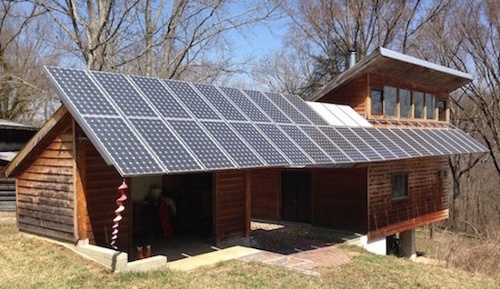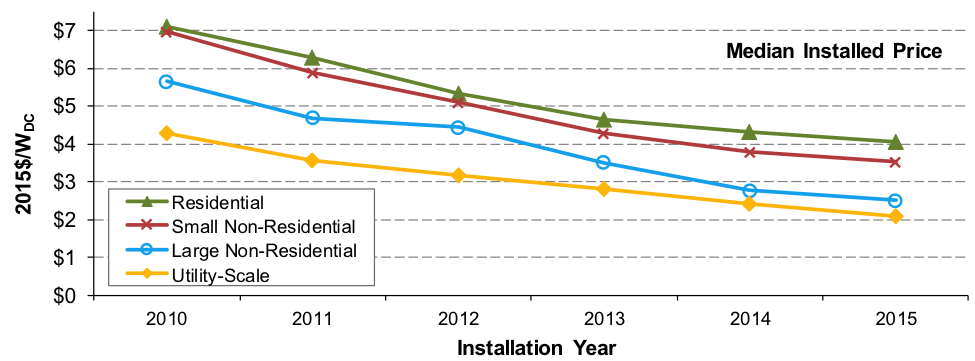The Cost of Solar Energy Keeps Dropping, But…

Solar energy has sex appeal. If you want to show the world you’re doing something to reduce pollution, you put photovoltaic (PV) panels on your roof to generate clean electricity. Even better, you drive a plug-in hybrid or an all-electric car and charge your car’s batteries with your solar panels. The good news for solar enthusiasts is the cost of installing a solar electric system on your home just keeps falling and falling. Let’s take a look at some data. Then I’ll throw in a little cautionary note at the end.
Solar energy has sex appeal. If you want to show the world you’re doing something to reduce pollution, you put photovoltaic (PV) panels on your roof to generate clean electricity. Even better, you drive a plug-in hybrid or an all-electric car and charge your car’s batteries with your solar panels. The good news for solar enthusiasts is the cost of installing a solar electric system on your home just keeps falling and falling. Let’s take a look at some data. Then I’ll throw in a little cautionary note at the end.
2 new studies on the cost of solar
Last month I saw that Lawrence Berkeley National Laboratory (LBNL) had published a study showing that the cost of solar has fallen to about half of what it was in 2010. The graph below shows the data.
Residential solar, the laggard in the group above, fell from a little over $7 per watt in 2010 to about $4 per watt in 2015. The others all fell to half or less of their 2010 prices.
Just yesterday I received an email from the National Renewable Energy Lab (NREL) with word of another study on the falling cost of solar. This one, titled U.S. Solar Photovoltaic System Cost Benchmark: Q1 2016 (pdf), includes the first quarter of 2016. Here are the data:
Their report shows the costs for other sectors, too, but here I just posted the graph for residential solar. The LBNL report shows an average of about $4/watt in 2015. The NREL report shows $2.93/watt for the first quarter of this year.
These numbers are great. I’ve been a solar enthusiast for a long time, and I recall the days — not that long ago actually — when everyone was saying, “Solar will really take off when we can get the production up and the cost down.” The number I remember as the threshold was a dollar per watt, but that was just for the PV modules themselves. As you can see above, we hit that mark four years ago in 2012.
You might think it’s time to rush out and buy that solar electric system you’ve always wanted. But…
Is solar our best investment?
Yes, solar electricity is absolutely a good thing. Don’t get me wrong. We need to keep it coming and keep those costs falling. As David Roberts wrote at Vox recently, we need electrify everything and clean up our electricity.
Having said that, I now have to turn your attention to another aspect of cost. The costs noted above are first costs, the cost to install those solar electric systems. Let’s take a look at the cost of producing electricity now.
The American Council for an Energy Efficient Economy (ACEEE) does a lot of great work to promote energy efficiency. In an article titled Solar and energy efficiency need to work together like peanut butter and jelly, they wrote about a recent analysis they’ve done of the cost per kilowatt-hour (kWh) of solar and efficiency. Here are their main results:
They found that it’s cheaper to save a kilowatt-hour than to generate a kilowatt-hour. But are their numbers realistic? As a former home performance contractor myself, I saw the cost of $2,943 and energy savings of 3,414 kWh and had suspicions. When I looked at the 230 page paper detailing the analysis, I saw that they’re talking about incremental costs. That makes more sense.
Other reasons to do efficiency first
But here’s the thing. The battle between solar and efficiency isn’t a battle at all. They need to be working together. Yes, we need solar energy. But we can’t forget about energy efficiency just because the installed cost of solar has fallen so much. They need to work together.
PHIUS’s Passive House standard does this. After moving away from arbitrary energy reduction targets, the program now has optimized targets for different climates. It doesn’t make sense to keep adding more and more insulation when you’ve gone past the point where it’s more cost effective to put PV on the roof.
Another problem that’s starting to crop up is this thing called the duck curve. Solar electricity floods the grid in the afternoon and then creates a huge problem in the evening when the traditional generation sources have to ramp up way faster than they’re currently capable. Efficiency, along with more west-facing PV, can solve that problem.
So, yeah, solar energy has sex appeal. It’s the beautiful woman or hunky guy of the energy world. But you don’t want to forget your protection — energy efficiency — before you go over there and get something started.
Related Articles
How Dirty Is Your State’s Electricity?
Electricity Demand and the Duck Curve
Why a New Standard for Passive House?
NOTE: Comments are moderated. Your comment will not appear below until approved.
This Post Has 12 Comments
Comments are closed.


I’m hoping building
I’m hoping building integrated photovoltaic (BIPV)takes off with Elon musk making an announcement in late October. Having the solar function as the roof will make it cheaper for new builds to capitalize on solar and incentivize homeowners needing a roof replacement take the plunge and go solar.
Solar power is sexy and makes
Solar power is sexy and makes for great click rates and hand clapping around the Facebook campfire; but in the macro, intermittent power is a big problem on the grid as it grows in impact. You yourself have discussed the duck curve in CA. Here is a great article on the subject. Maybe you can enlighten me and reduce my stress, but in the game of reducing carbon in the air and water, solar power seems a limited tool. https://ourfiniteworld.com/2016/08/31/intermittent-renewables-cant-favorably-transform-grid-electricity/
Stu, yes, the duck curve is a
Stu, yes, the duck curve is a problem and no one has figured out how to keep those PV modules producing when the Sun goes down in the evening. But there are solutions: efficiency, orienting more PV modules to face west, and storage. As things stand now, though, you are correct that solar by itself has limits.
Eric, BIPV is a good
Eric, BIPV is a good technology that can help. We still need efficiency, though.
Good point. There are still
Good point. There are still many low hanging fruits that can have a great impact on energy consumption. Being in the business of actually doing testing for Energy Star for equipment it is impressive how much the manufacturers have managed to drop consumption, in particular in idle mode. A level VI power adapter is under 0.1 W no load condition.
Now for housing, my experience buying an Energy Star house has been sobering. Except for a few CFL light bulbs in the house, not a single appliance was ES rated, not the fridge, not the stove or anything in the kitchen. And it is so easy to find an ES fridge…..for the bigger item the hot water tank was not ES and the HVAC was for sure not ES….it does not even have a AHRI certificate….really disappointing. I have already replaced my hot water tank with a heat pump unit from GE and it has been great so far. But fixing the HVAC and all it’s issues is a venture in it’s own. Maybe I should start blogging about that?
But thanks for a good article and a good point. All the little items in the house adds up and should be done before throwing solar on the roof. The solar system will be smaller too if the other items have been taken care of first.
$2.93 per watt??? Does that
$2.93 per watt??? Does that price includes rebates? What brand? Our prices in North TX for SunPower 327 panels are $4.50/watt before any rebates (Austin is $4.10/watt). I know there are other brands, like Renogy, LG or cheap Chinese PV that are cheaper, but when one includes the warranty, SunPower is no brainer.
HVAC issues? We never hear
HVAC issues? We never hear about HVAC issues on this blog. 🙂
“It’s the beautiful woman or
“It’s the beautiful woman or hunky guy of the energy world. But you don’t want to forget your protection — energy efficiency — before you go over there and get something started.”
– LOL oh boy.
An interesting phenomenon I
An interesting phenomenon I’ve noticed may help drive efficiency on the coattails of newly installed PV systems. Homeowners interested in acquiring a PV system have typically done some modest energy efficiency; new windows, LED lamps, added insulation, etc. However, after their utility bill goes to zero (except for connection fees), they suddenly become interested in driving their consumption down further, especially if their banked kWh’s runs dry about February.
While before PV they could have lowered their monthly bill, now they want to ensure that any cash-flow is from the utility to them, and they want to grow their kWh bank as much as possible.
In the past, reducing their utility bill was a modest “reward”, but after going solar, homeowners have “incentive” to save. Reducing the outflow of money versus changing the direction of cash-flow is a very powerful psychological shift, one that the home performance industry should capitalize on.
I agree it makes no sense to
I agree it makes no sense to devote resources to PV without first addressing the envelope. I cringe when I see 10kW systems on 1970’s vintage slump block homes with with single pane glass an no wall insulation. That being said, we should reject any approach that doesn’t look at the metrics for a given project. There’s always a point beyond which it makes more sense to apply PV. That point varies dramatically by market, depending on climate, local energy costs, incentives and net metering rules.
The bigger question prospective solar customers should be asking is how likely they are to lose retail net metering in their particular market, given the current trend by utilities and regulators to curb rooftop solar.
Excellent article as always
Excellent article as always Allison. I expect the falling cost of PV has hit bottom or close to it. If NREL expects installers to work for less every year that is unlikely. PV Business is not sustainable supplying modules below cost, for very long. We are starting to see PV module failures after 3-4 years because of lower grade parts and quality control.
There is an innovative hybrid called SunPump that combines Solar plus Heat Pump to achieve more. Indoors it is like Geothermal, and outdoors it uses new Photon Panels on the roof to perform direct exchange by circulating refrigerant, rather than water and underground exchange. The result is a low cost package that is uniquely both Renewable Energy (solar) AND Energy Efficiency (heat pump). Unlike Solar, a SunPump can produce on demand Day and Night, comes with 8 kW thermal storage plus backup, and is about 1/3 the cost installed. For someone that wants hydronic floor heating and hot water, this is a compelling package with a low cost Zero-carbon footprint.
https://www.sunpump.solar/
Consumer Reports two issues
Consumer Reports two issues ago said it is finally the right time to buy solar for a residence but I don’t recall they said a word about doing conservation measures in consort. They definitely need a conservation guy on staff since the influence the decisions of so many!